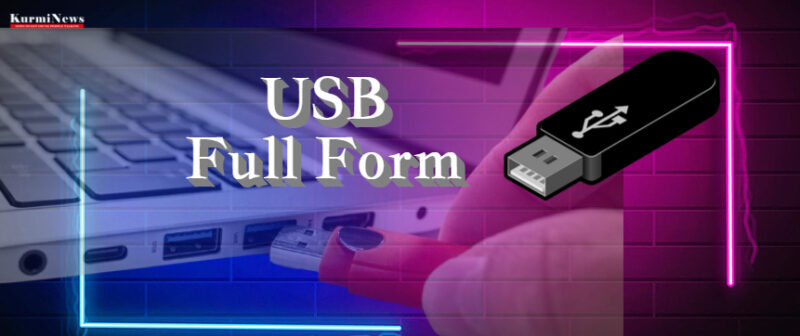USB Full Form: A USB, or Universal Serial Bus, serves as a standard interface facilitating communication and connection between computers and electronic devices. Its primary function is to facilitate the seamless transfer of data across devices. Connecting a USB device to a computer is straightforward: simply insert the USB device into the computer’s USB port, and it will be automatically detected, initiating its functionality.
Advantages of USB: USB Full Form
- Simplified connectivity: All devices can be attached to a single cable using standardized cables and connectors.
- Consistent port usage: Devices remain connected to the same port on a computer, ensuring convenience and reliability.
- Wide device compatibility: USB supports a diverse range of devices, including remote controls, external hard disk drives, digital cameras, etc.
- Power management: Computers can efficiently manage power distribution and battery charging when connected to high-capacity battery packs via USB. USB Full Form
- Streamlined programming: Programmers can compile multiple programs using a single code base, enhancing efficiency.
- Safety and reliability: USB connections are known for their safety and reliability, ensuring fast and secure data transfer.
Types of USB: USB Full Form
USB (USB Full Form) encompasses various types and functionalities, including:
- Standard USB
- Fast Full-Form USB
- High-Speed USB
- Extended USB
- Wireless USB
- Low Power USB
- Memory Stick USB
- Display Link USB
- Memory Stick Screen Capture USB
- Mirroring Display USB
- Pillar RAID HDMI Display USB
Each type caters to specific requirements and usage scenarios, offering tailored solutions for diverse needs.
Uses of USB: USB Full Form
USB finds widespread applications across various industries and domains. It facilitates:
- Connectivity and communication between devices
- Technical components of USB-enabled devices
- Compatibility with a wide range of devices
- USB to Serial conversion for integrating standard USB devices into serial interfaces
- Power supply for portable electronic devices such as cell phones, MP3 players, and digital cameras
Supported USB Devices: USB Full Form
USB supports a vast array of devices, including but not limited to:
- Phone Chargers/Bumpers: Devices designed to power portable electronic devices through USB ports, ideal for travelers seeking convenient power supply on the go.
Benefits and Drawbacks of USB (USB Full Form) Connectivity
Benefits:
- Unified Connectivity: USB ports allow for the connection of multiple peripherals to a single high-speed port on a computer, streamlining the setup and organization of devices.
- Peripheral Compatibility: The USB plug enables easy connection to various peripherals such as media players, printers, and external hard disk drives, enhancing versatility and usability.
- Convenient Placement: USB sockets are typically located on the back of computers, offering accessible and tidy connection points. On mobile phones, USB ports can be found on both the back and sides, ensuring flexibility in device placement.
Connecting USB with a Computer: USB Full Form
To connect a USB device with a computer, follow these steps:
- Connect USB Device: Use a USB cable to connect the USB device to an available USB port on the computer.
- Insert USB Device: Insert the USB device into the computer’s USB port.
- Device Detection: Upon insertion, the device will be automatically detected by the computer, allowing users to access its functionalities.
- Resetting USB Devices: To reset a USB device to its factory default settings, press and hold the “−” button until the device resets. USB Full Form
Drawbacks:
- Identification Challenge: Differentiating between USB Full Form devices and simpler types like A, B, and C can be challenging, especially with the first USB port drivers in Windows only recognizing basic types. This issue is compounded by the absence of a standardized medium-pin-pin numbering system.
- Controller Compatibility: USB devices with specific controller numbers may only be compatible with corresponding controllers, leading to potential connectivity issues. Changing the controller number in the device’s firmware can mitigate this problem.
- Rapid Standard Evolution: USB standards evolve rapidly, posing challenges for users to keep up with the latest advancements and compatibility requirements. USB Full Form
Conclusion:
In conclusion, USB (USB Full Form) connectivity offers numerous benefits in terms of unified connectivity, peripheral compatibility, and convenient placement. However, challenges such as identification complexities and controller compatibility issues underscore the need for ongoing adaptation and understanding of evolving USB standards.
FAQs about USB Full Form
What is USB and what is its primary function?
USB, or Universal Serial Bus, serves as a standard interface facilitating communication and connection between computers and electronic devices. Its primary function is to facilitate the seamless transfer of data across devices.
How do you connect a USB device to a computer?
Connecting a USB device to a computer is straightforward: simply insert the USB device into the computer’s USB port, and it will be automatically detected, initiating its functionality.
What are the advantages of USB connectivity?
USB offers several advantages, including simplified connectivity, consistent port usage, wide device compatibility, efficient power management, streamlined programming, and safety/reliability in data transfer.
What are the different types of USB and their functionalities?
USB encompasses various types, including Standard USB, Fast Full-Form USB, High-Speed USB, Extended USB, Wireless USB, Low Power USB, Memory Stick USB, Display Link USB, Memory Stick Screen Capture USB, and Mirroring Display USB. Each type caters to specific requirements and usage scenarios.
What are the drawbacks or challenges associated with USB connectivity?
Challenges include the identification complexity between USB Full Form devices and simpler types, controller compatibility issues, and the rapid evolution of USB standards, necessitating users to keep up with the latest advancements and compatibility requirements.

